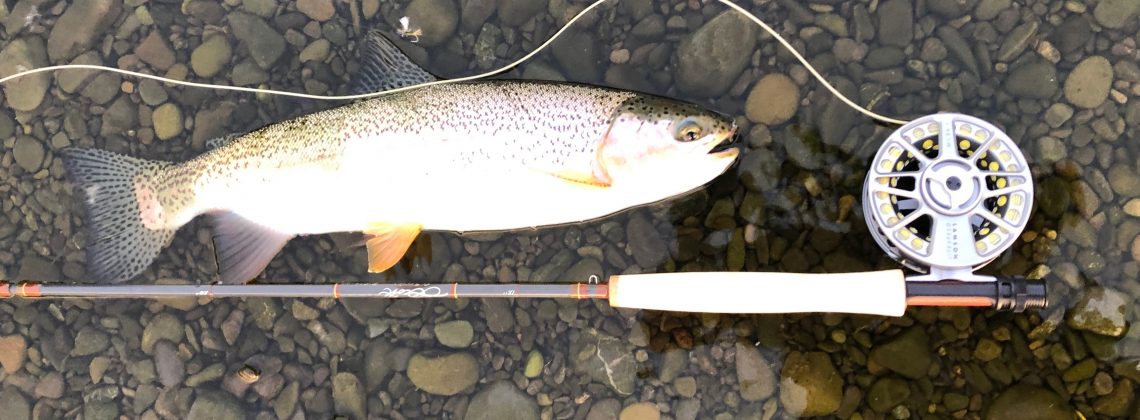Fighting Big Fish

Fighting big trout demands really good technique to consistently land them. A three pound fish is often bigger than the usual fish many foreigners fight, and they struggle with the technique required to play fish that are measured by weight, not length as they are in New Zealand.
Even when fighting smaller fish it is sensible to use a good technique for fighting them. This reinforces good technique and ensures when you do hook a good fish you are prepared to fight it technically correctly.
Plan the Fight
Before casting plan the fight. This basically means working out where the structures are and where you are going to land the fish. If there are trees, rocks or other structures in the water you need a plan to keep the fish away from them, so you have a rough idea before the fish gets close to them and causes you to panic.
Knowing where you are going to land a fish is also good technique, whether you are using a net or not. I do not carry a net, and do not think this affects my landing rate or I would carry one.
The Take
It is important to put pressure on the fish immediately. If you ever have a fish take the fly, hook itself and take off before you strike you will understand why. Fish that are not pressured on the take seem to have a lot more fight in them, and will tear around all over the place without being in much control.
The balance between striking too hard and breaking off and not striking hard enough and missing has a third component – striking hard enough to so the fish does not charge off. Other than trial and error there is no real technique to describe to get this right.
Stay Downstream of the Fish
I catch most of my fish on a #16 Hare & Copper. Small hooks are extremely likely to come out of the fish’s mouth if it gets down stream of you, and then turns back up facing you. The same thing happens with size 14s. Bigger hooks are more secure so you are less likely to lose them when they get downstream of you, but good technique dictates try to stay downstream of the fish.
If the fish does get downstream of you chase it hard, and keep pressure on the fish while it is heading downstream by holding the rod across the stream so the fly is being pulled back into the fish’s mouth while it is facing down stream. As soon as it turns swing the rod downstream and try to keep pulling the fly back into the fishes mouth.
Get the Line on the Reel
There are huge advantages in getting your flyline onto the reel rather than having slack line between the first guide and the reel and using your hand to control the tension on the fish.
Line on the reel allows the drag setting of the reel to take over, so there is consistent pressure applied to the fish. It means that the slack line cannot tangle around anything, so if you have to chase a fish down stream you can.
The early part of this fight shows me getting the line back onto the reel as quickly as i possibly could.
Stay Close to the Fish
The more line you have out the more likely it is for the fish to get off. So keep the fish on as short a line as possible, moving towards it if it is running hard. Maintaining tension on a fish a long way away is far harder than maintaining it close to you, so try to stay close to the fish.
I stay close to this fish, moving slightly upstream at the beginning of the fight to ensure i dont let too much line get out.
The Rod as a Shock Absorber
Fly rods have a lot of give in them, which acts as a big shock absorber when the fish takes off suddenly. To take advantage of this it is important not to completely load up the rod – keep the rod tip slightly down so there is some give if the fish takes off. If you pull back hard on the rod and load it up so there is no give you will often lose the fish to a sudden surge.
If the fish really takes off lower the rod tip further, as this will lessen the drag applied to the fish.
Note how I move the rod towards the fish when it surges and jumps. This reduces the tension at a critical time.
Fly Line Out of the Water
The extra diameter of a fly line compared to a leader means that it has a lot more drag through the water. This drag puts extra pressure on the fish, and if the fish changes direction it can create slack line. Where possible keep the fly line out of the water, and the fish high in the water. If it is near the surface it is more likely to be unable to bury you in structure.
Side Strain
This puts more pressure on the fish than an upright rod. It also allows for changing the angle the fly is being pulled back into the fishes mouth.
Landing bigger trout on a five weight rod with a five pound leader is why I like trout fishing over any other type of fishing. With every other species I have caught there is far less technique required to land the fish. Most saltwater fish fight hard but do not have structure to bust you off on. Most of the fight is about holding as the fish runs then recovering line. Without the structure or the very light line used for trout fishing the technique required to land saltwater fish is nowhere near as complex as it is for trout.
